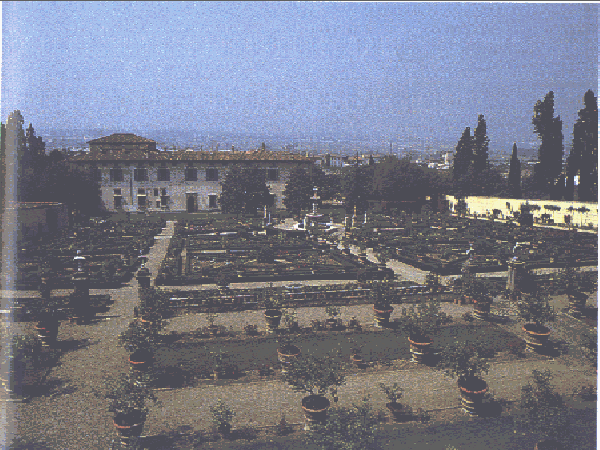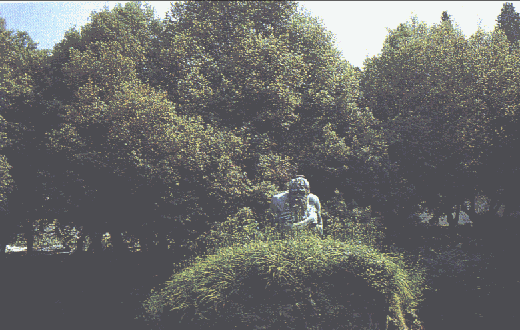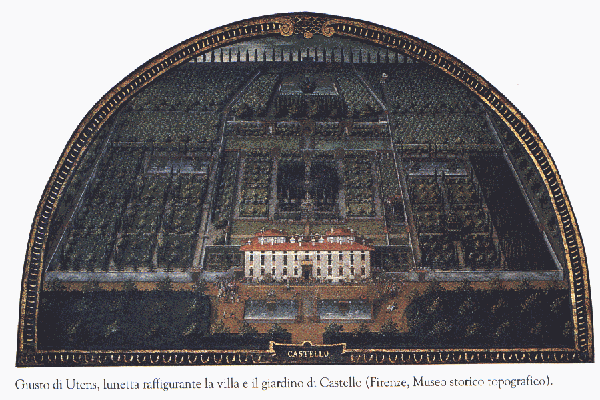INTRODUCTORY INFORMATION SHEET ON THE GARDEN
OF VILLA CASTELLO
The site, where at present you can see the villa and
the garden of Castello, is named after the Roman aqueduct that anciently linked Florence
to Sesto Fiorentino. As a matter of fact, the Medieval word Castellum means
reservoir, water tank, hence the name Castello.
 In 1477 Giovanni and Francesco di Pierfrancesco de’
Medici, from the branch of the Popolani, bought houses and lands in this area and they
began the first restoration of the manor house. Since the beginning a small walled garden
had lain to the west side of it. In this "secret garden" rare plants were
cultivated. This villa is particularly linked to the history of that Medici branch that
lived there from its origins. In fact the Grand Dukes who reigned in Tuscany from the 16th
to the 17th century descended from this part of the family. Giovanni dalle
Bande Nere spent his childhood in Castello and so did his son Cosimo, who was to become
the first Grand Duke of Tuscany (b.1519-d.1574).
In 1477 Giovanni and Francesco di Pierfrancesco de’
Medici, from the branch of the Popolani, bought houses and lands in this area and they
began the first restoration of the manor house. Since the beginning a small walled garden
had lain to the west side of it. In this "secret garden" rare plants were
cultivated. This villa is particularly linked to the history of that Medici branch that
lived there from its origins. In fact the Grand Dukes who reigned in Tuscany from the 16th
to the 17th century descended from this part of the family. Giovanni dalle
Bande Nere spent his childhood in Castello and so did his son Cosimo, who was to become
the first Grand Duke of Tuscany (b.1519-d.1574).
Cosimo himself commissioned the sculptor and
architect Niccolò Tribolo with the project for the realization of a new big garden that
could propagandize the power of the Medici family to their guests. This was done by using
symbolic images for statues and fountains that were thought out by the scholar Benedetto
Varchi. He was told to show the ability of the Medici family in ruling their territory
like a splendid garden. The dynasty, which boasted the new title of grand dukes, was
celebrated by comparing the Florentine State to a wonderful garden full of flowing water.
According to the original plan, the water used for the irrigation was supposed to flow
from a tank which was situated in the wood at the top of the garden (in the middle of
which, in 1565, the bronze statue by Bartolomeo Ammannati that represented the Apennines
was placed). This water was to run through canals into fountains illustrating Tuscan
mountains and rivers, and was to reach the two principal fountains of the "Giardino
Grande" (or big garden). The bases of both were sculpted by Niccolò Tribolo and
Pierino da Vinci, but one is crowned by the bronze group of Hercules and Anteus made by
Bartolomeo Ammannati, which can be still admired today in the Villa Petraia, and the other
one, made by Gianbologna showing Venus-Florence wringing out her hair, is at the moment
located in the Villa Petraia too.
In regard to his plan for the garden, Tribolo had
aligned the longitudinal axis of the garden with the centre of the original part of the
manor house. The latter was later enlarged on the side facing Florence over the years.
Tribolo’s scheme also included placing the Grotto of Animals at the end of the
longitudinal axis and of dividing the garden into sixteen squares, as we see it today.
When Niccolo’ Tribolo died, Davide Fortini and
Giorgio Vasari continued his work and later Raffaello Pagni and Gherardo Mechini completed
it, at the end of the sixteenth century, during the reign of the Grand Duke of Tuscany,
Ferdinando I (born 1549 – died 1609).
From the botanical point of view, this garden was
designated, since its very origins (the first evidence dates back to 1544) as a privileged
place for the cultivation of citrus fruits, whether in vase or on espalier. One of the
most important collections of potted citrus fruit trees in the world can still be admired
here today. It boasts five hundred specimens of different dimension age and variety, some
of them rare examples descending from a variety cultivated by the Medici themselves.
Many were the members of this family that dedicated
themselves to the culture and study of special plants, and some of them played important
roles in the maintenance and development of the garden of Castello. The two most prominent
Medici were Cardinal Giovan Carlo (1611-1663) and the Grand Duke Cosimo III (1642-1723),
who collected a great variety of jasmines in a greenhouse called "Stufa dei
Mugherini". The most sweet smelling of these flowers was called "Granduca
di Toscana".
After the Medici family came to an end, the garden
went through a short period of decadence, but then it passed under the control of the
House of Lorraine. The new Grand Dukes of Tuscany took an interest in this place and had
the big greenhouse called "Stanzone dei Limoni " built, to house the
citrus fruits trees .
Today the Superintendency of Monuments, responsible
for the preservation of this important site, is trying to re-establish its double aspect
of artistic and natural beauty.
Here is some more specific information on some areas
of particular interest.
THE FOUNTAIN OF HERCULES
It is situated in the place where formerly the
fountain of Venus/Florentia was. The latter was moved to the Villa of Petraia in
1788,under the Lorrainers.
The marble parts of the base and of the basins were
sculpted by Niccolò Tribolo and Pierino da Vinci between 1538 and 1548.
 Description
of the fountain: it is an eight-sided basin in the centre of which an eight-sided prism
rises (on each side of the prism we can see a bas-relief representing a marine animal). On
the prism the first leg of the fountain stands, supported by eight lion paws. The first
basin is followed by a second one surmounted by two couples of children playing with some
geese out of whose beak water used to flow. Further above the second foot supports the
upper level basin, decorated with four Capricorn-headed statues. The four puttos holding
some fish on the upper part of the fountain was the base for the bronze group representing
Hercules and Anteus, sculpted by Bartolomeo Ammannati between 1559 and 1560 and now
located in the villa.
Description
of the fountain: it is an eight-sided basin in the centre of which an eight-sided prism
rises (on each side of the prism we can see a bas-relief representing a marine animal). On
the prism the first leg of the fountain stands, supported by eight lion paws. The first
basin is followed by a second one surmounted by two couples of children playing with some
geese out of whose beak water used to flow. Further above the second foot supports the
upper level basin, decorated with four Capricorn-headed statues. The four puttos holding
some fish on the upper part of the fountain was the base for the bronze group representing
Hercules and Anteus, sculpted by Bartolomeo Ammannati between 1559 and 1560 and now
located in the villa.
THE GROTTO OF THE ANIMALS

Covered with limestone concretions and rustic
mosaics, this grotto houses three fountains consisting of marble basins surmounted by
groups of animals carved in different stones. The original scheme of this grotto was
designed by Niccolò Tribolo, but was probably completed by Giorgio Vasari.
In the middle of the grotto was a statue maybe
representing Orpheus, who charmed animals with his music. There were also some bronze
birds made by Gianbologna and Bartolomeo Ammannati, which can now be admired at the
Bargello museum in Florence. Water used to spurt out of these bronze winged creatures,
from the animals and from the floor, creating the water show for which the grotto became
very famous. (Montaigne visited Castello garden in 1581, and he was so astonished that he
described it in the memories of his trip to Italy).
APENNINE
It is a bronze work by Bartolomeo Ammannati, which
may be dated back to 1563-65. It represents the personification of the Apennine mountain
chain, which is the source of the rivers of Tuscany. (see the original iconographic plan
of the garden).
ORTACCIO
Worth visiting are the jasmines and the beautiful
collection of aromatic plants, recent acquisition of the garden, situated in a place where
in the past plants of the same type had been cultivated in vase.

FREE TOUR
ORIGINAL SCRIPT BY : SILVIA MASCALCHI
EDITED BY : JENNIFER CELANI & GIOVANNI QUERCIOLI
TRANSLATION BY : 4°Ae..r..i.c.a., I.T.C.G.
"P. Calamandrei"
Iniziativa in collaborazione con la SOPRINTENDENZA PER I BENI AMBIENTALI
E ARCHITETTONICI di FIRENZE , PRATO e PISTOIA.

FREE
GUIDED
TOUR
 In 1477 Giovanni and Francesco di Pierfrancesco de’
Medici, from the branch of the Popolani, bought houses and lands in this area and they
began the first restoration of the manor house. Since the beginning a small walled garden
had lain to the west side of it. In this "secret garden" rare plants were
cultivated. This villa is particularly linked to the history of that Medici branch that
lived there from its origins. In fact the Grand Dukes who reigned in Tuscany from the 16th
to the 17th century descended from this part of the family. Giovanni dalle
Bande Nere spent his childhood in Castello and so did his son Cosimo, who was to become
the first Grand Duke of Tuscany (b.1519-d.1574).
In 1477 Giovanni and Francesco di Pierfrancesco de’
Medici, from the branch of the Popolani, bought houses and lands in this area and they
began the first restoration of the manor house. Since the beginning a small walled garden
had lain to the west side of it. In this "secret garden" rare plants were
cultivated. This villa is particularly linked to the history of that Medici branch that
lived there from its origins. In fact the Grand Dukes who reigned in Tuscany from the 16th
to the 17th century descended from this part of the family. Giovanni dalle
Bande Nere spent his childhood in Castello and so did his son Cosimo, who was to become
the first Grand Duke of Tuscany (b.1519-d.1574).  Description
of the fountain: it is an eight-sided basin in the centre of which an eight-sided prism
rises (on each side of the prism we can see a bas-relief representing a marine animal). On
the prism the first leg of the fountain stands, supported by eight lion paws. The first
basin is followed by a second one surmounted by two couples of children playing with some
geese out of whose beak water used to flow. Further above the second foot supports the
upper level basin, decorated with four Capricorn-headed statues. The four puttos holding
some fish on the upper part of the fountain was the base for the bronze group representing
Hercules and Anteus, sculpted by Bartolomeo Ammannati between 1559 and 1560 and now
located in the villa.
Description
of the fountain: it is an eight-sided basin in the centre of which an eight-sided prism
rises (on each side of the prism we can see a bas-relief representing a marine animal). On
the prism the first leg of the fountain stands, supported by eight lion paws. The first
basin is followed by a second one surmounted by two couples of children playing with some
geese out of whose beak water used to flow. Further above the second foot supports the
upper level basin, decorated with four Capricorn-headed statues. The four puttos holding
some fish on the upper part of the fountain was the base for the bronze group representing
Hercules and Anteus, sculpted by Bartolomeo Ammannati between 1559 and 1560 and now
located in the villa. 